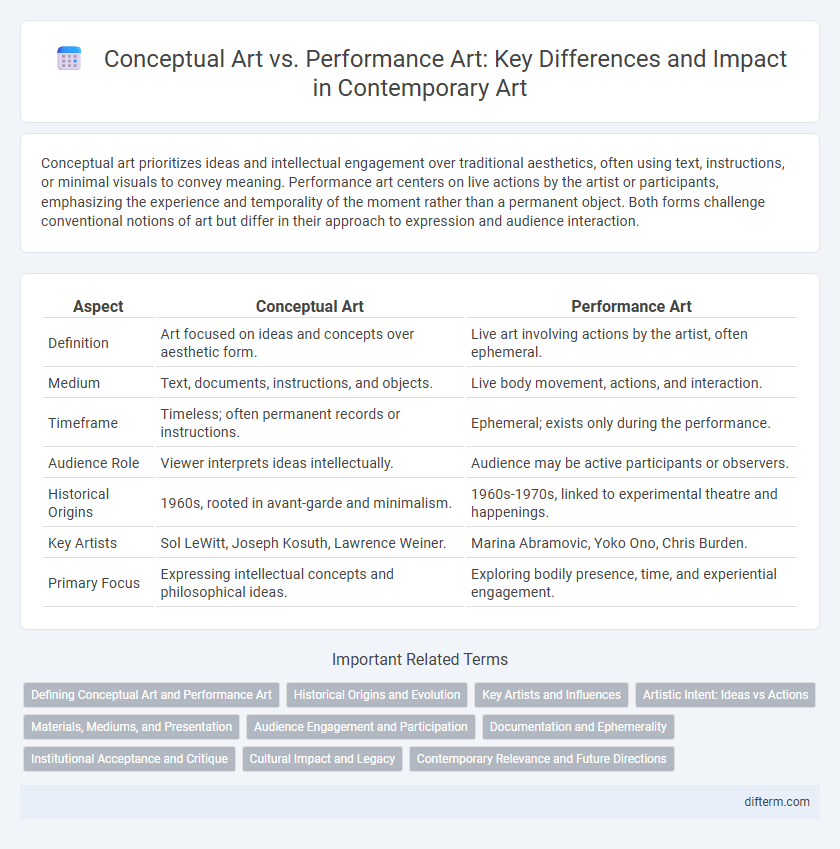Conceptual art prioritizes ideas and intellectual engagement over traditional aesthetics, often using text, instructions, or minimal visuals to convey meaning. Performance art centers on live actions by the artist or participants, emphasizing the experience and temporality of the moment rather than a permanent object. Both forms challenge conventional notions of art but differ in their approach to expression and audience interaction.
Table of Comparison
| Aspect | Conceptual Art | Performance Art |
|---|---|---|
| Definition | Art focused on ideas and concepts over aesthetic form. | Live art involving actions by the artist, often ephemeral. |
| Medium | Text, documents, instructions, and objects. | Live body movement, actions, and interaction. |
| Timeframe | Timeless; often permanent records or instructions. | Ephemeral; exists only during the performance. |
| Audience Role | Viewer interprets ideas intellectually. | Audience may be active participants or observers. |
| Historical Origins | 1960s, rooted in avant-garde and minimalism. | 1960s-1970s, linked to experimental theatre and happenings. |
| Key Artists | Sol LeWitt, Joseph Kosuth, Lawrence Weiner. | Marina Abramovic, Yoko Ono, Chris Burden. |
| Primary Focus | Expressing intellectual concepts and philosophical ideas. | Exploring bodily presence, time, and experiential engagement. |
Defining Conceptual Art and Performance Art
Conceptual art prioritizes ideas and concepts over traditional aesthetic and material concerns, emphasizing the intellectual engagement of the viewer. Performance art involves live presentations by artists, using the body as a medium to convey messages through actions, movement, and time-based experiences. Both forms challenge conventional art definitions by focusing on ephemeral elements and audience interaction.
Historical Origins and Evolution
Conceptual art emerged in the 1960s as a movement prioritizing ideas over aesthetic form, drawing from earlier Dada and Surrealist influences that challenged traditional art norms. Performance art evolved in parallel, rooted in the early 20th century with Futurist and Fluxus movements emphasizing live, ephemeral experiences that defy static art objects. Both genres transformed artistic expression by shifting focus from material creation to participatory and intellectual engagement.
Key Artists and Influences
Conceptual art, championed by artists such as Sol LeWitt and Joseph Kosuth, centers on the idea behind the artwork rather than its physical form, heavily influenced by Marcel Duchamp's readymades and Dadaism's rejection of traditional aesthetics. Performance art, shaped by pioneers like Marina Abramovic and Yoko Ono, emphasizes live, ephemeral actions often exploring themes of endurance, vulnerability, and audience interaction, drawing from Fluxus movement's experimental ethos. Both movements challenge conventional art paradigms, with conceptual art prioritizing intellectual engagement and performance art foregrounding the artist's presence and the immediacy of experience.
Artistic Intent: Ideas vs Actions
Conceptual art emphasizes the primacy of ideas where the artistic intent centers on conveying intellectual concepts and challenging traditional aesthetics through language, documentation, or imagery. Performance art prioritizes actions and the artist's presence, using live gestures, body movements, or interactions to communicate meaning directly to the audience in real time. Both forms redefine art by shifting focus from physical objects to the significance of thought processes and ephemeral experiences.
Materials, Mediums, and Presentation
Conceptual art emphasizes ideas over physical materials, often utilizing text, diagrams, and ready-made objects to convey meaning, prioritizing intellectual engagement over visual aesthetics. Performance art relies on the artist's body, time, and space as primary mediums, transforming live actions or events into ephemeral, experiential presentations that challenge traditional art forms. Both practices disrupt conventional art objects by shifting focus from tangible artworks to concepts and transient experiences, broadening definitions of art and viewer interaction.
Audience Engagement and Participation
Conceptual art challenges traditional aesthetics by prioritizing ideas over physical form, provoking thoughtful reflection rather than direct interaction. Performance art, by contrast, demands active audience participation, often involving spectators as integral components of the piece and fostering immersive, real-time experiences. Both forms redefine artistic boundaries, yet performance art uniquely transforms observers into collaborators, enhancing communal engagement.
Documentation and Ephemerality
Conceptual art prioritizes ideas over physical form, often relying heavily on documentation such as text, sketches, and photographs to convey its meaning and ensure longevity. Performance art emphasizes ephemerality, with live actions existing momentarily and only partially preserved through recordings or eyewitness accounts, highlighting the transient nature of the work. The contrast lies in conceptual art's fixation on lasting intellectual engagement through documentation versus performance art's embrace of impermanence and experiential presence.
Institutional Acceptance and Critique
Conceptual art challenges traditional artistic norms by emphasizing ideas over aesthetic form, often facing initial resistance from mainstream institutions but gradually gaining acceptance through critical discourse and museum acquisitions. Performance art confronts conventional boundaries by prioritizing live action and audience interaction, provoking institutional critiques related to documentation, preservation, and commercialization. Both art forms continue to shape institutional narratives by questioning art's definition and engaging viewers in evolving cultural debates.
Cultural Impact and Legacy
Conceptual art challenges traditional notions of artistic value by prioritizing ideas over aesthetics, influencing contemporary cultural discourse and expanding definitions of creativity. Performance art engages audiences through live, often provocative expressions that highlight social and political issues, leaving a lasting legacy on participatory and immersive art practices. Both movements redefine art's role in society, fostering critical reflection and opening new avenues for cultural dialogue and activism.
Contemporary Relevance and Future Directions
Conceptual art emphasizes ideas over aesthetic form, influencing contemporary art practices focused on intellectual engagement and social critique. Performance art advances this by integrating live actions and audience interaction, reflecting current trends in experiential and participatory art. Future directions suggest a convergence where digital technologies enhance immersive experiences, expanding the boundaries of both conceptual and performance art.
Conceptual art vs Performance art Infographic

 difterm.com
difterm.com